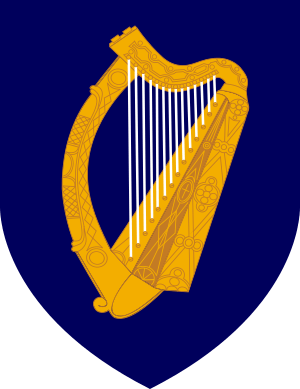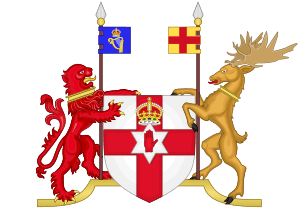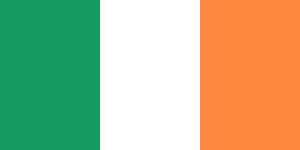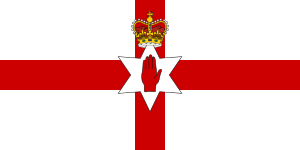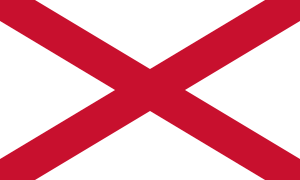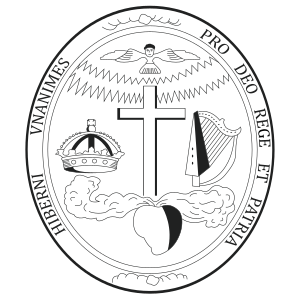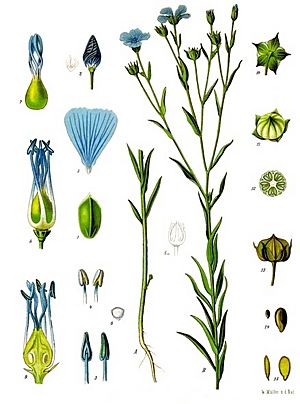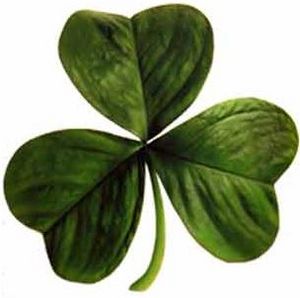National symbols of Ireland, the Republic of Ireland and Northern Ireland facts for kids
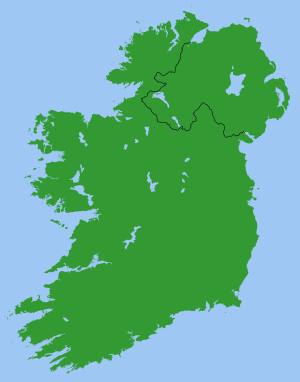
Symbols of Ireland are special marks, pictures, or objects that represent the country. Ireland was divided into two parts in 1922: the Republic of Ireland and Northern Ireland. Many of Ireland's symbols existed long before this division.
Unlike some other countries, Ireland and Northern Ireland don't often have official laws that define their symbols. Instead, these symbols become popular through common use or by different groups of people.
You can see these symbols in official places, like on flags, coats of arms, postage stamps, and currency (money). They also appear in less formal ways, such as in books, art, folk art, and on monuments, clothes, and even as names for parks or streets.
Contents
Official Symbols
Coats of Arms
The official symbol of Ireland is a gold Celtic harp on a blue background. This harp is a special kind of harp called a cláirseach.
Northern Ireland doesn't have its own official coat of arms today. However, the old government of Northern Ireland had one from 1924 to 1972. It featured an Irish elk and a banner from the House of de Burgh.
Flags
The flag of Ireland is a tricolour (a flag with three vertical stripes) of green, white, and orange. It was first flown in 1848. The green stands for Irish Catholicism, the orange for Irish Protestantism, and the white in the middle represents peace between the two groups.
Even though it was meant to be a symbol of peace, some people in Northern Ireland who want to stay part of the UK see this flag as a symbol of Irish republicanism and the Irish Republican Army.
The flag of Northern Ireland (called the Ulster Banner) was officially used between 1953 and 1973. The Union Jack is also widely used in Northern Ireland. It has been the flag of the United Kingdom since 1801. It combines symbols from England (Saint George's Cross), Scotland (St Andrew's Saltire), and Ireland (Saint Patrick's Saltire).
St Patrick's Saltire has not been used much as a symbol of Ireland since Ireland became independent from the United Kingdom. Today, it is mostly used by older institutions in Ireland that still have links to the UK, like Trinity College Dublin. Some people have suggested it should become Northern Ireland's official flag.
Mottos
The Republic of Ireland does not have an official national motto. However, "Erin go bragh" (which means "Ireland Forever") is a very popular unofficial motto. Northern Ireland has used the motto Quis separabit?, which is Latin for "Who shall separate us?". This comes from a Bible verse: "Who shall separate us from the love of Christ?".
Another motto, "The Irish United for God, King, and Country," was used by a group called Confederate Ireland long ago. The Society of United Irishmen also had a motto: "Equality: it is new strung and shall be heard."
Animals and Plants
Birds
The northern lapwing was chosen as the Republic of Ireland's national bird in 1990.
Northern Ireland does not have an official national bird. However, the Eurasian oystercatcher was unofficially chosen in 1961. Some people have suggested the rook as a possible national bird for Ireland because of its strength and ability to handle challenges.
In 2019, the European golden plover and roseate tern appeared on special "National Bird" stamps in Ireland.
Bulls
Cattle have been very important in Irish stories and history for hundreds of years. They were a source of milk, cheese, leather, and beef. They also showed how important someone was in society. Bulls have long been linked to high status in Ireland. They appear as important animals in many Irish myths, like the famous story of Táin Bó Cúailnge (The Cattle Raid of Cooley). The importance of bulls in Irish myths shows that raising cattle and even raiding them was a big part of life long ago. Bulls were seen as a strong symbol of power among kings.
Dog Breeds
The Irish wolfhound is generally seen as Ireland's national dog breed. However, some people, like the famous Irish leader Michael Collins, thought the Kerry Blue Terrier could also be a national dog.
Fish
The northern pike is Northern Ireland's national fish.
For the Republic of Ireland, "coarse fish" are often described as the national fish. This group includes fish like bream, perch, and carp.
Sheep
Raising sheep and making wool products have been historically important in Ireland. Sheep are often seen on souvenirs sold to tourists.
Wild Mammals
It's not entirely clear which wild land mammal is considered the national animal. The Irish Hare has been described as a national animal, as has the red deer. Even though it's extinct, the Irish elk is also strongly linked to Ireland.
Plants
The national plant of Ireland is the shamrock. It is a type of clover.
The Fuchsia magellanica flower, sometimes called "tears of God" in Irish, has also been called the national flower, even though it's not native to Ireland.
Flax is widely used as a symbol of Northern Ireland. It is the emblem of the Northern Ireland Assembly. This is because of Ulster's important history in the linen industry.
Trees
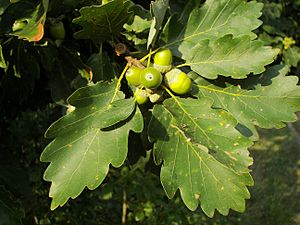
The national tree of the Republic of Ireland is the sessile oak. It was declared the national tree in 1990. Some people also consider the strawberry tree to be the national tree.
Culture
Dance
Irish dance is Ireland's national dance. It's known for its quick footwork and upright posture.
Musical Instruments
The Celtic harp (cláirseach), great Irish warpipes (píob mhór), uilleann pipes, and the bodhrán (a type of drum) have all been called national musical instruments. A gold Celtic harp on a green background has historically been used in symbols to represent Ireland.
The Lambeg drum, often used in parades in Northern Ireland, is seen as an unofficial national instrument there. The flute, also linked to these parades, is another associated national instrument.
National Anthems
"Amhrán na bhFiann" ("The Soldiers' Song") is the national anthem of the Republic of Ireland. It was written in English in 1907 and later translated into Irish. The Irish version is the official anthem.
"Ireland's Call" has been used by the Ireland national rugby union team and other sports teams since 1995.
"God Save the Queen" (or "God Save the King" depending on the monarch) is used by Northern Ireland because it is part of the UK. However, its use is sometimes debated among Irish nationalists. The Irish folk song "Londonderry Air", sometimes with the lyrics of "Danny Boy", is often used as a substitute national anthem for Northern Ireland.
Personifications
Ireland has several female figures that represent the country:
- Hibernia: Often shown as a beautiful, gentle girl.
- Kathleen Ní Houlihan: A symbolic figure often linked to Irish nationalism.
- The Sean-Bhean bhocht: This means "the poor old woman." She represents Ireland needing help from young Irish men to gain freedom.
- Banba, Fódla, and Ériu: These are three ancient goddesses who are said to have given their names to Ireland.
- Róisín Dubh (Dark Little Rose): Another symbolic name for Ireland, often found in poetry and songs.
Poets
Both Thomas Moore (1779–1852) and W. B. Yeats (1865–1939) are considered national poets of Ireland.
Other Symbols
Drinks
Irish breakfast tea is described as the national non-alcoholic drink.
Among alcoholic drinks, Irish whiskey is the national spirit. Popular brands include Jameson Irish Whiskey, Tullamore Dew, and Bushmills.
Poitín is a traditional Irish spirit, often made from potatoes. It was made illegally for a long time but was fully made legal in 1997. It now has special protection in the European Union.
Stout, a dark beer made with roasted oats or barley, is the national beer. Guinness is a very famous stout and a strong symbol of Ireland.
Irish coffee, made with coffee, whiskey, sugar, and cream, was invented in 1943. It is described as the national cocktail.
Food
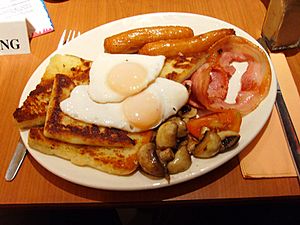
The national dish of Ireland is Irish stew. Other popular national dishes include the full Irish breakfast (or Ulster fry in Northern Ireland) and bacon and cabbage.
Gemstone
The national gemstone of Ireland is Connemara marble.
Patron Saint
Saint Patrick, a bishop from the 5th century who was born in Britain, is Ireland's patron saint. His feast day is celebrated worldwide.
Sports
Gaelic games are considered Ireland's national sports. These include Gaelic football, hurling, camogie (a stick-and-ball game similar to hurling, played by women), rounders, and Gaelic handball.
Irish road bowling is another traditional Irish sport.
Card Game
Many sources say that forty-fives (also called "45" or "25"), or its related game Spoil Five, is the Irish national card game.
Weapon
A writer named Gerald of Wales once described the battle axe as Ireland's national weapon.


